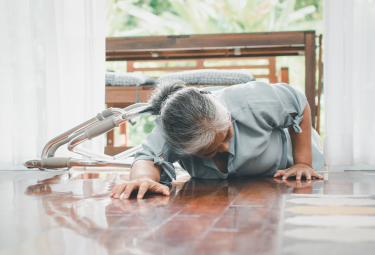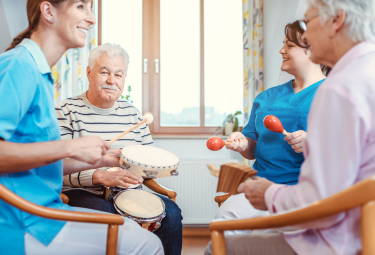Preventing Falls at Home: Room by Room
September 9, 2024Many falls happen at home, where we spend much of our time and tend to move around without thinking about our safety. There are many changes you can make to your home that will help prevent falls and better ensure your safety.
Floors, stairways, and hallways
- Ensure there are handrails on both sides of any stairs, and make sure they are secure. Hold the handrails when you go up or down stairs, even when you are carrying something. Don’t let anything you’re carrying block your view of the steps.
- Ensure there is good lighting with light switches at the top and bottom of stairs and on each end of a long hall. Consider using motion-activated lights that plug into electrical outlets and automatically turn on when you walk by them to help illuminate stairwells and pathways.
- Keep areas where you walk tidy. Don’t leave books, papers, clothes, or shoes on the floor or stairs.
- Check that all carpets are fixed firmly to the floor, so they won’t slip. Put no-slip strips, which you can buy at any hardware store, on tile and wooden floors.
- Don’t use throw rugs or small area rugs.
- Don’t walk on slippery, newly washed floors.
Bathrooms
- Mount grab bars near toilets and on both the inside and outside of your tub and shower.
- Place nonskid mats, strips, or carpet on all surfaces that may get wet.
- Remember to leave a light on in the bathroom at night or use a night light that turns on automatically in the dark.
Bedrooms
- Put night lights and light switches close to your bed.
- Keep a flashlight by your bed in case the power goes out and you need to get up.
- Place a landline or well-charged phone near your bed.
Kitchen
- Keep frequently used pots, pans, and kitchen utensils in a place where they are easy to reach.
- Clean up spills immediately.
- Prepare food while seated to prevent fatigue or loss of balance.
Outdoor spaces
- If you have steps leading to your front door, make sure they are not broken or uneven.
- Add non‐slip material to outdoor stairways.
- Keep the lawn, deck, or porch areas clear of debris, such as fallen branches.
- Consider installing a grab bar near the front door to provide balance while you are locking or unlocking the door.
- Turn on your porch light at night and if you leave during the day but plan on returning home after dark.
- In the winter, treat outdoor walkways with an ice melt product or sand to make them less slippery.
Other living areas
- Keep electrical cords near walls and away from walking paths.
- Arrange your furniture (especially low coffee tables) and other objects so they are not in your way when you walk.
- Make sure your sofas and chairs are the right height for you to get in and out of easily.
- Keep items you use often at waist level or within easy reach.
- Don’t stand on a chair or table to reach something that’s too high — use a “reach stick” instead or ask for help. Reach sticks are special grabbing tools that you can buy at many hardware or medical-supply stores. If you use a step stool, make sure it’s steady and has a handrail on top. Have someone stand next to you.
- Don’t let your cat or dog trip you. Know where your pet is whenever you’re standing or walking.
- Keep a list of emergency numbers in large print near each landline phone and save them under “favorites” on your mobile phone.
If you have fallen, your doctor might suggest that an occupational therapist, physical therapist, or nurse visit your home. These health care providers can assess your home’s safety and advise you about making changes to lower your risk of falls.
Tools to get help
If you’re concerned about falling, set up systems to ensure you can get help if you fall. One option is installing an emergency response system. If you fall or need emergency help, you push a button on a special necklace or bracelet to alert 911. There is a fee for this service, and it’s usually not covered by insurance.
Another option is to carry a well-charged cordless or mobile phone with you as you move throughout the house. Have close friends and family on speed dial. Consider setting up a smart home device (a small speaker that listens and responds to commands when you call its name) that can quickly connect you to contacts or emergency response teams. Some smartwatches can be set up to make emergency calls at the push of a button and others can even detect sudden fall-like movements and automatically call for help. Ask family and friends for help setting up these tools.
Home improvement resources
Many state and local governments have education and/or home modification programs to help older people prevent falls. Check with your local health department, search the Eldercare Locator, or call 800-677-1116 to find your local Area Agency on Aging to see if there is a program near you.
To learn more, please visit https://www.nia.nih.gov/health/falls-and-falls-prevention/preventing-falls-home-room-room.


